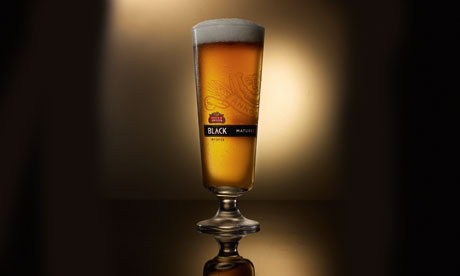A black day for lager?
Despite the launch of a new upmarket Stella Artois there's still a dearth of readily available, quality lagers. What do you rate as the least bad high street lager?

Stella Artois Black.
Curious news from Stella Artois. This autumn, Stella's parent company,AB InBev, will launch Stella Artois Black, which isn't - much to the consternation of beer blogger, Pete Brown - a dark lager, but rather a 4.9% Stella deluxe for, what Marketing Magazine, calls "posh" drinkers.
Brewed in Belgium, as opposed to the UK, where (despite the continental branding) standard Stella Artois and its 4% variant are made, this new recipe, golden beer will also be matured - or lagered, the process that imbues lager with flavour - for longer than normal; a fact which will be central to the SA Black marketing push.

The lack of transparency, however, is laughable. It might have been matured for longer, but unless we know how long "longer" is, that information is useless and, typically, AB InBev aren't saying. "I'm afraid the specifics of our maturation times are proprietary so I don't have that information to share," explains a spokesperson. All InBev will specify is: "Stella Artois Black is matured for more than twice as long as the average for our other lagers."
Are they being coy because the lagering time for standard Stella is embarrassingly short? Or because SA Black is matured for nowhere near the length of time a genuinely good lager should be? Budvar, for instance, is matured for 90 days. Who knows? Either way, it means that SA Black will arrive, not as a hotly anticipated improvement in mainstream beer, but shrouded in suspicion - with everyone frompublicans to blogging brewers ready to pounce. I haven't tasted it, yet, but I'm not getting my hopes up. If InBev were launching a new brew of genuine quality, they would be keen publicise its "craft brewed" virtues. As it is, this just smacks of the usual brand diversification, more smoke and mirrors for gullible fools.
Which is a pity, because Lord knows the world sorely needs a good mass market lager. In this month's Restaurant Magazine there is a feature which, using research by drink analysts Canadean, lists the Top 20 global beer brands by volume sales. Lager is clearly the world's favourite beer style. All 20 beers listed are lagers. That the appalling likes of Corona, Coors, Brahma, Budweiser and Bud Light occupy five of the top ten positions, however, tells you just how desperate the situation now is. Outside of China (Tsingtao, Yanjing and Snow also make the top 10), the international brewing conglomerates, led by SAB-Miller and Anheuser-Busch InBev, seem determined to remove any trace of character from this once fine drink.

Which leaves us with a conundrum. If you want to drink a good readily available lager, what are your choices? Of those lagers commonly stocked in pubs and supermarkets, which is the best?
Personally, Amstel, Becks and Heineken are as low as I'll go. In terms of overly gassy thirst-quenching lager of little discernible character, they are the best of a bad bunch. Becks may be a curious drink: very bitter and dry, yet slightly too sweet, with a curious astringent hop aftertaste, but it is, at least, discernibly beer. That cannot be said of Fosters, Carling, Budweiser and those other brands which, insomuch as they taste of anything, have all developed their own uniquely offensive, jarringly odd flavour profiles that seem only tangentially related to lager.

For salvation, I would look to that Czech Holy Trinity: Budvar,Staropramen and Pilsner Urquell. Staropramen is now owned by CVC Capital Partners, having been sold late last year by AB InBev, while Pilsner Urquell belongs to SABMiller. Connoisseurs will often tell you, that, consequently, the quality of these once proudly artisan pilsners has deteriorated. Certainly, if you were drinking any of them in Prague, 20 years ago - the still state-owned Budvar included; which is not necessarily as well-regarded in the Czech Republic as it is here - they probably don't taste as good today, bought from your local Asda.
That said, tasting all three, ahead of writing this post, they are still head and shoulders above the high street competition. They're all different,Pilsner Urquell is dry, stridently bitter; Staropramen has an intense, almost prickly upfront hop profile; Budvar is more rounded and full-bodied. All of them, however, work the herbal, spicy, almost medicinal qualities of their constituent Saaz (also known as Žatec) hops in a way that make you wonder why anyone would ever drink any other lager. Basically, these three taste like real beer.
When you're gasping at an unfamiliar bar or picking up something to take to a mate's house and are confronted by the usual substandard suspects, what do you pick as the best of a bad bunch?



















